I’ve been using Readwise Reader since it was released in beta, and I love it more than a little: it’s an all-on-one reader app for RSS feeds, email newsletters, PDFs, and ebooks, with helpful tools for annotating, sharing, summarizing, filtering, and searching. Here’s what it looks like:
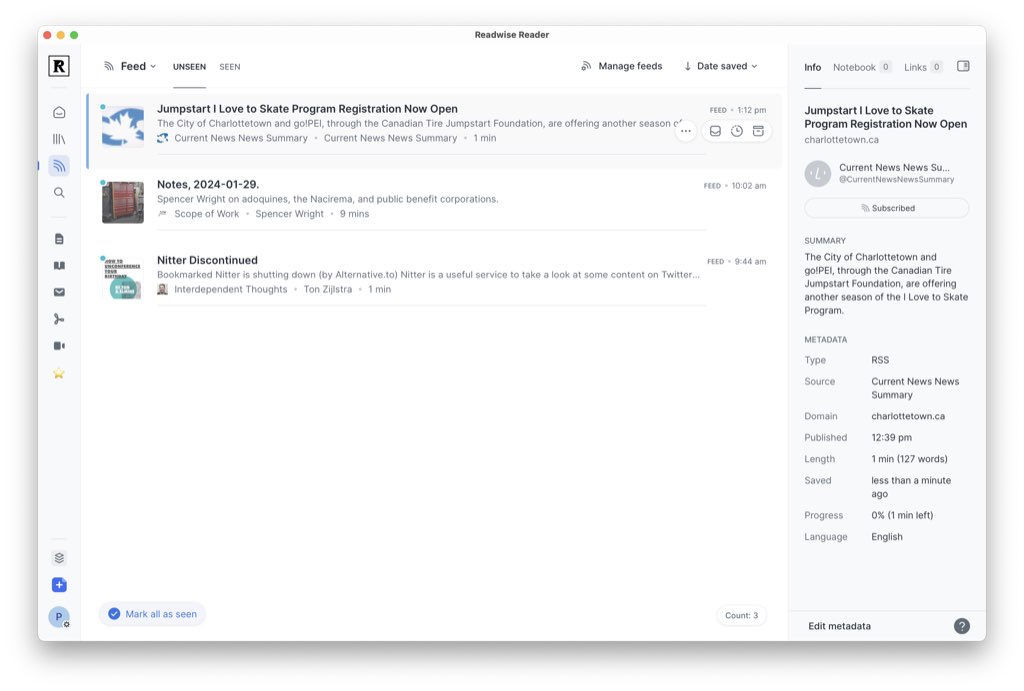
This morning in my Reader I found Re-Noted: 6 Ways to Use a Diary, a rumination by Jillian Hess on the ways we diarize. I loved the scans of sundry diaries—Alan Rickman, in particular—and the link to a YouTube tutorial from Lynda Barry about “a method of remembering.”
Another item in my Reader this morning was from Readwise itself, an issue of Wisereads, the project’s newsletter—an uncommonly rich and useful newsletter—that showcases things you might want to use Reader to read. Among those was Dan Wang’s 2023 letter, a letter that starts:
The trunk of an elephant might feel cool to the touch. Not what one expects, perhaps, from 200 pounds of writhing muscle, strong enough to uproot a tree, which tapers down to two “fingers,” giving it enough delicacy to detect the ripest berry on a shrub, and pluck it. Feeling an elephant’s trunk draws you to her other great feature: melancholic eyes that are veiled by long and dusty lashes. This combination of might with the suggestion of serene contemplation is surely the reason that elephants seem to embody a special state of grace.
I encountered several of these big beasts on a trek through the mountains of northern Thailand in December. The occasion was a “walk and talk” organized by Kevin Kelly and Craig Mod, who launched a dozen people on a 100 kilometer walk over seven days from Mount Inthanon to the center of Chiang Mai.
Yet another item, also from Readwise, was an update on Reader itself. One of the new features announced therein was the ability to create “Bundles” in Reader, a collection of links to things that you can then one-click publish to a public URL:
Somewhat experimental: You can now create themed collections of documents (aka “bundles”) with pretty landing pages for easily sharing with others. To create a bundle, first save a filtered view in the web app, click the down chevron next to its name, and select Enable public link. You can optionally add a description and a cover image to spice up the public landing page. When a recipient hits the Open in Reader call-to-action, a filtered view will be created in their account populated with these documents.
To illustrate a use of the feature, there was a link to one such bundle, Dan & Meghan Sabbatical. The image illustrating that bundle? An elephant. And one of the stories in the bundle, Where have we been?! Chiang Mai, Thailand, explained:
Chiang Mai is known for its beautiful landscapes and mountainous terrain. It’s also the home of Asian elephants! Ever since I was a little girl and found out that my brother got to ride elephants in Taiwan (where my mom is from) before I was born, I’ve always wanted to go for an elephant ride. Elephants are such majestic, enormous creatures that it seemed like one of those things you have to do in a lifetime. So we signed up to spend a morning with the Elephants at Ran-Tong Elephant Save & Rescue Centre. They had a great mission to save and care for elephants that have been victims of cruel treatment while working at logging sites and the like.
Dan was a little less excited than I was to see and ride the elephants, but once we got there he was just as wide-eyed as I was! They are amazing creatures, so giant yet so gentle.
This brought to mind our own trip, 21 years ago, to Chiang Mai where we too rode an elephant.
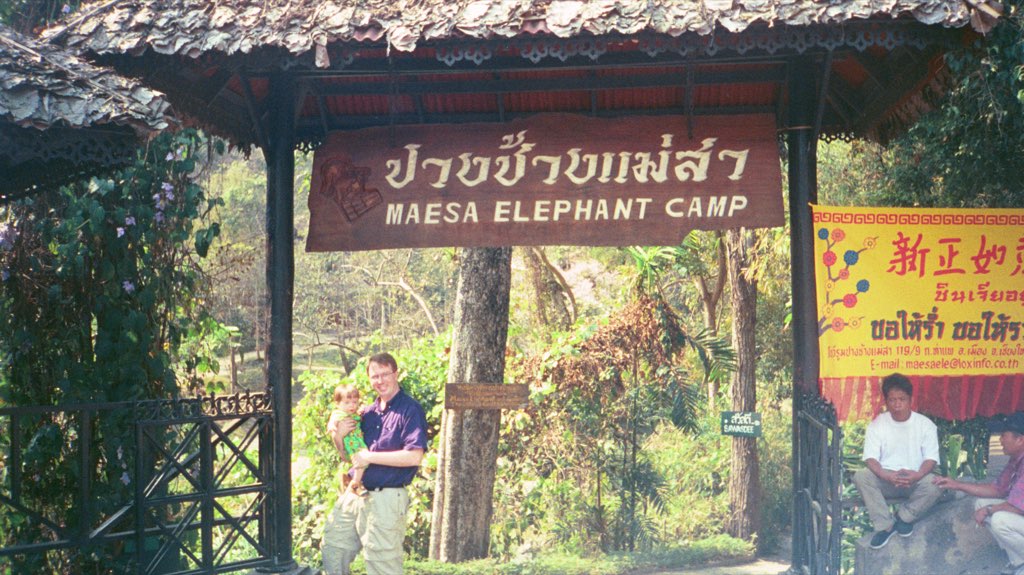
Suffice to say, I had elephants on my mind this morning.
During a brief lull in my Reader reading, a question occurred to me: where is the nearest elephant?
In other words, if I wanted to lay hands on an elephant right now, how far would I need to travel.
There is a thing for every happenstance thought, and elephants-in-captivity is no different: The Elephant Database came to my aid, a result of a search for “elephants in Eastern Canada.”
The entry that immediately jumped out at me was the elephant at Anil Canada Ltd. hardboard plant in East River, Nova Scotia. Because, well, that didn’t make any sense to me at all.
My East River elephant curiosity led me to the Barbara Hinds fonds in the library at Halifax’s Dalhousie University, and specifically to the section labelled File MS-2-130, Box 3, Folder 3 - Newspaper clippings and other material about the Anil elephant:
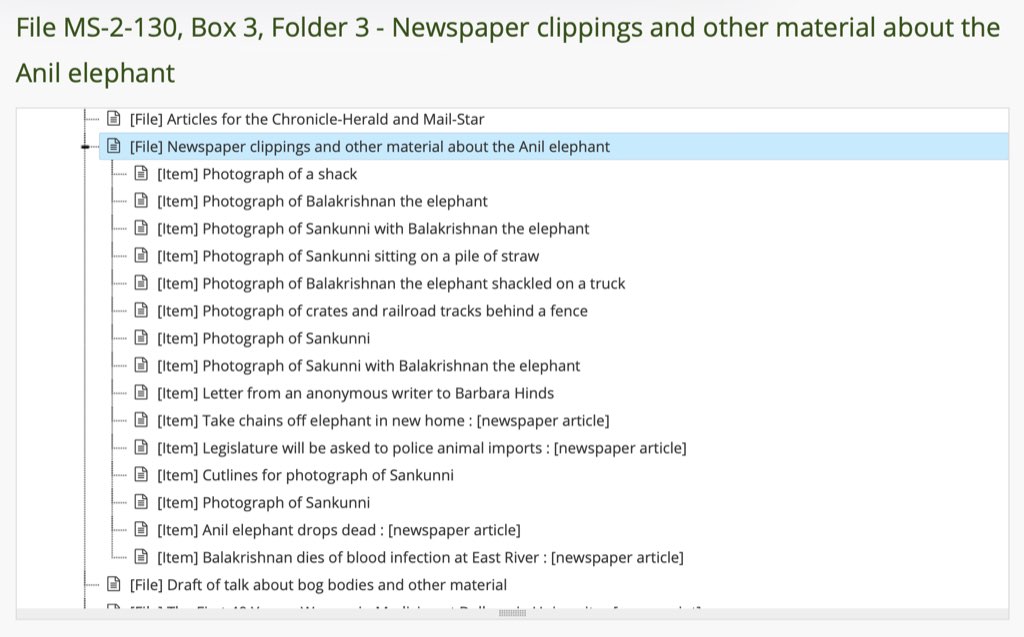
Barbara Hinds was a Halifax journalist. She worked at the Chronicle Herald and Mail Star for 33 years, and those documents, all related to her reporting, tell the story of how, in 1967, an elephant named Balakrishnan was brought from India, with its mahout Sankunni, as a cruel publicity stunt to mark the opening of an India-backed hardboard plant:
Before being brought to Canada as an advertising gimmick, Balakrishnan worked in South India. When he was selected for emigration to Canada, his mahout, Sankunni had to go with him. They trained and worked together for five years, and traditionally, an elephant and his keeper stay together until death separates them. So, Sankunni, speaking the little known dialect of Malayalam, left his family behind and brought Balakrishnan to a life of leisure in Nova Scotia. To embark on board ship for the trip to Canada, the team of giant animal and small, lion-hearted man walked 110 miles across the hot India countryside. They took five days to travel the distance to the Bombay dockside.
After being moved from Halifax, his port of entry, to East River, Lunenburg County, Balakrishnan lived in idleness. He did no work and he walked little more than a few paces. He was first chained to a great spruce tree at the edge of the woods near a railway crossing where the trains whistled their approach.
People were able to visit him and feed him bananas, which he relished during the summer of 1967. A neighbor Mrs. Raymond Meisner, used to warm his drinking water for him until he/ was moved away into a shanty near the plant’s main entrance (which was quieter) and where he was still accessible to an admiring public during the fall.
Balakrishnan eventually succumbed to either the harsh conditions, the Canadian winter, or something else—his cause of death wasn’t conclusive:
Balakrishnan, Anil’s white elephant, dropped dead in his shackles at 5 o’clock this morning in his shed at East River. The 25-year old former working elephant had been sick for a week and was
visited by a veterinarian surgeon during the weekend and given an injection. For the past seven days, Balakrishnan had not eaten, to the concern of his keeper,
Sankunni. Yesterday, he drank a lot of water, but still refused to eat.
The story of Balakrishnan and Sankunni is told well in a 2019 National Film Board film, Balakrishna, which uses the reminiscences of Winton Cook, 13 at the time of their arrival in Canada, with animation combined with archival video and photos to demonstrate both the cruelty of the endeavour, and how Balakrishnan played an important role in one boy’s teenaged life.
But back to Barbara Hinds.
Also in her archives, under the section Personal notes of Barbara Hinds, is a collection of her diaries, like this one. It’s fascinating: a view into the personal and working life of a Haligonian journalist living in my lifetime.
There is a page of Charles Darwin quotes:
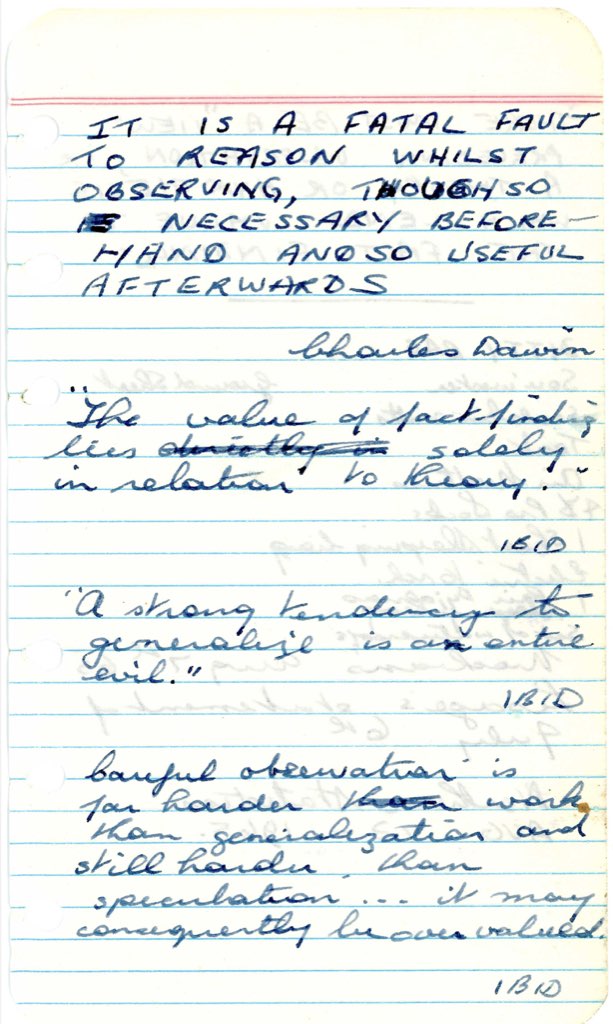
Dalhousie University Archives,
Diary of Barbara Hinds, Accession 2009-003
And a shopping list:
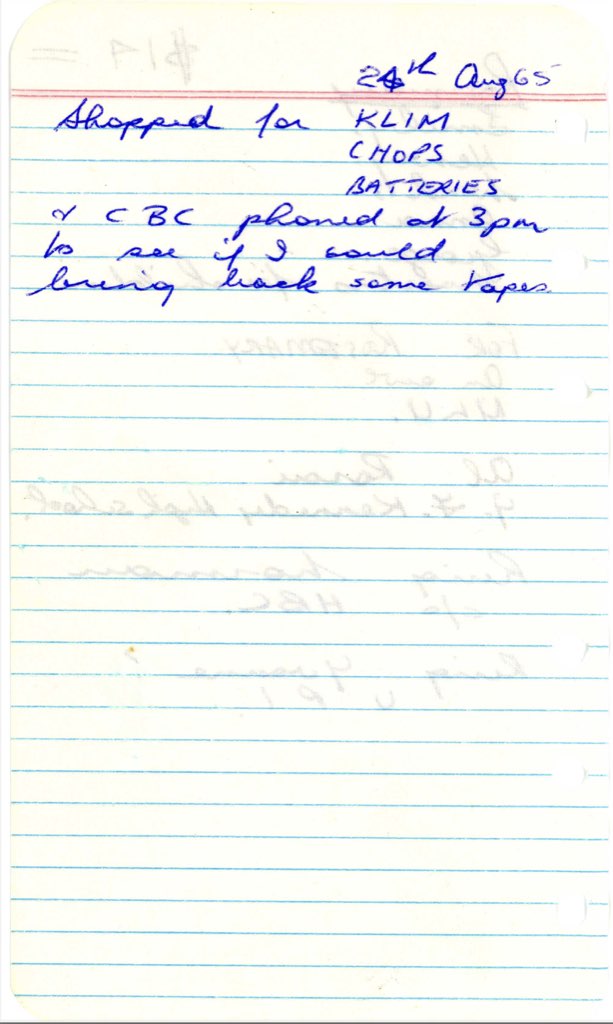
Dalhousie University Archives,
Diary of Barbara Hinds, Accession 2009-003
Notes from her reporting in the north:
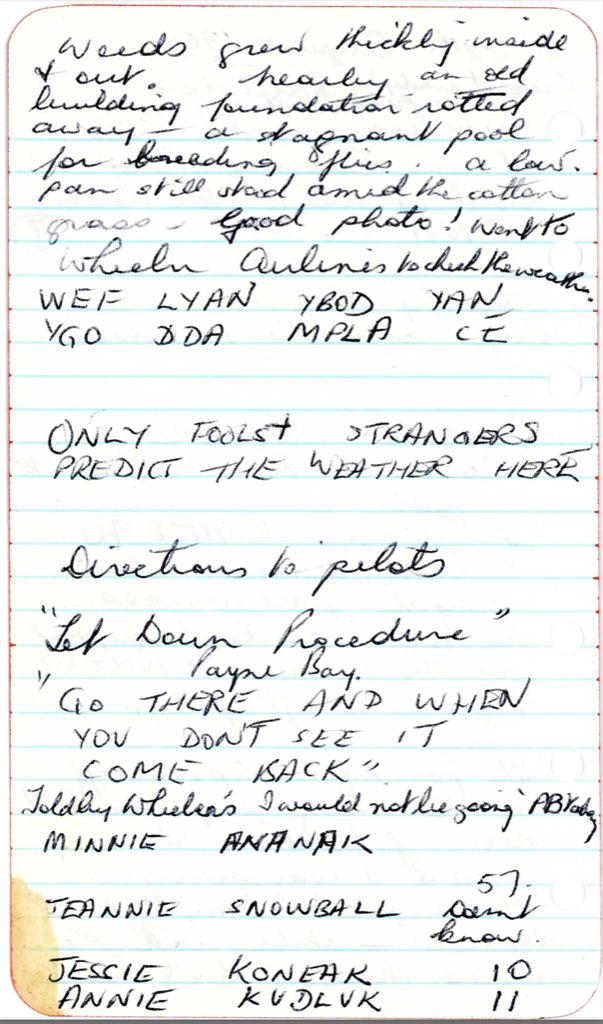
Dalhousie University Archives,
Diary of Barbara Hinds, Accession 2009-003
Like Hinds, Jillian Hess noted Charles Darwin, in her Re-Noted post:
Some of you might remember my post on Jim Henson’s diary of single-line entries. But he wasn’t the only one to use this method.
Like Henson, Charles Darwin also kept a diary filled with one-line entries. From 1838-1888, Darwin recorded his life in a single diary. In general, he notes professional events on the left-hand pages, while he reserves the right-hand pages for personal notes.
My father, who died in 2019, was also a single-line-entry diary writer.
Once, a few years before he died, I asked him what he wanted done with his diaries after his death. “Throw them away,” he said. He didn’t think they’d be of any interest or value, and perhaps, though they don’t contain anything salacious or revealing, he didn’t like the thought of us knowing that on such and such a day he was pissed off at Mom.
After 1990, Dad switched from keeping a diary in pencil to using one long Microsoft Word file. When I found the file on his desktop after he died, I discovered he’d password-protected it. His frugality played to my hand in this regard, however: he hadn’t updated Word in a long, long time, so this file was of an era where cracking the password was trivial. Which is how we can, today, read his diary entries for the 28 years between 1990 and 2018, 2.2 million words in total.
This is how I know that, on January 29, 1990, he cleaned his office; on the same day a year later, in 1991, he “missed French class and used time to skim St. Lawrence contract terms of reference and discussed with Stephane by phone.”
In 1992, he “wrote monthly report”; in 1993 he was “home sick”; in 1994 he a Mom had dinner out while the computer backup at Mom’s library ran; in 1995 it was “some difficulty in getting the Compaq trackball mouse to work, finally resolved.”
On this day in 1999, Mom retired from her library position, and we all gathered at their house to surprise her; Dad noted “great dinner and chatted till about 2300 when we all went to bed exhausted.”
Two years later, “further on the polygon, the polygon coords used in the NAD83 maps of Trow cores when converted do not agree with the NAD27 coords from mplot,” an entry you could spend hours trawling Wikipedia to understand.
Dad’s 2018 entry for January 29, the last January 29 in the file, mentions some medical issues, a visit to the mall, cleaning up his email, returning a knife sharpener to Canadian Tire. He went to bed at 11:45 p.m.
I don’t learn much about my father by reading his diary. Looking at significant events in our family’s history, there’s sometimes a one-line mention, sometimes nothing. There’s scant introspection; nothing revealed. But I find them fascinating nonetheless; like wearing the L.L. Bean wool sweater of his that I keep in my closet still, when I browse them I feel a connection to him. There’s something about the workaday mechanics of his life being revealed that lets me invoke the memory of him more powerfully.
In her Your Daily Diary Will Teach You to Hear, Seem and Remember the World Around You, Lynda Barry describes what goes into your diary:
What goes into your diary are things that you noticed when you became present—that is to say when the hamster wheel of thoughts and plans and worries stopped long enough for you to notice where you were and what was going on around you.
I realize, reading this, that it’s that very thing that draws me close to Dad when I read things like “called Cas, more progress with the baby, Mike’s move went well.” These are contrails of moments of presence in his life: a call to my mother, a thought toward Olivia, an another for brother Mike, things he thought important enough to write down.
Perhaps, years from now, if these words survive, someone will take note that, on this day, I fell into an elephant and diary rabbit hole, and took several hours and 2,000 words to write about it. And maybe, if that person is you, you’ll feel a small kinship.
Hello!
 I am
I am
Comments
Loved this, Peter, gave me so
Loved this, Peter, gave me so much to think about.
Just loved this, Peter.
Just loved this, Peter. Partly because there's so much to chew on and partly because your thought/discovery process sounds a lot like my own. Lots to go away and think about, for me. Thanks.
I am so very different from
I am so very different from you…but I enjoy your Beautiful Mind as much as anyone. You are at your best down rabbit holes that I would never go down. …but I love to read of your adventures…and the quality of your writing makes for a wonderful journey. Thanks for past and future…
Add new comment